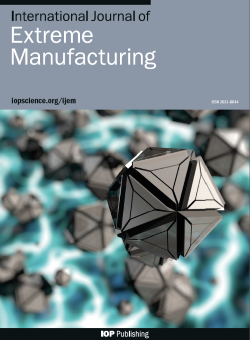为了了解激光增材制备Nd-Fe-B永磁体的显微结构特征、相选择和磁性能
IF 21.3
1区 工程技术
Q1 ENGINEERING, MANUFACTURING
引用次数: 0
摘要
Nd-Fe-B永磁体是能量转换和电子器件的关键部件。Nd-Fe-B磁体的主要磁性能,特别是矫顽力和剩余磁化强度,很大程度上取决于相特性和微观结构。本文采用真空感应熔炼(VIM)、激光定向能沉积(LDED)和激光粉末床熔炼(LPBF)技术制备了Nd-Fe-B磁体。详细阐述了Nd-Fe-B磁体的微观组织演变和相选择。结果表明,凝固速度(V)和冷却速度(R)是决定相选择的关键因素。在vim铸造Nd-Fe-B磁体中,由于R (2.3×10-1℃/s)较低,形成了大量的软磁α-Fe相(39.7 vol.%)和Nd2Fe17Bx亚稳相(34.7 vol.%),而硬磁Nd2Fe14B相仅为5.15 vol.%。随着V (<10-2 m/s)和R (5.06×103℃/s)的增大,led加工的Nd-Fe-B磁体中部分软磁α-Fe相(31.7 vol.%)被抑制,形成了更多的Nd2Fe17Bx亚稳相(47.5% vol.%),硬磁Nd2Fe14B相也出现了低值(3.4 vol.%)。因此,铸造和led加工的Nd-Fe-B磁体表现出较差的磁性能。与此相反,高V (>10-2 m/s)和R (1.45×106℃/s)导致液体形成硬磁性Nd2Fe14B相(55.8% vol.%), lpbf加工的Nd-Fe-B磁体中α-Fe相和Nd2Fe17Bx相的析出受到抑制。此外,{001}晶面上的强晶体织构是lpbf加工的Nd-Fe-B磁体剩余物增强的另一个原因。因此,lpbf加工的Nd-Fe-B磁体的矫顽力为656 kA/m,剩余量为0.79 T,最大能积为71.5 kJ/m3,具有与MQP (Nd-lean) Nd-Fe-B粉末增材制造加工的Nd-Fe-B磁体相当的优异磁性。本文章由计算机程序翻译,如有差异,请以英文原文为准。
Toward understanding the microstructure characteristics, phase selection and magnetic properties of laser additive manufactured Nd-Fe-B permanent magnets
Abstract Nd-Fe-B permanent magnets are critical components for energy conversion and electronic devices. The key magnetic properties of Nd-Fe-B magnets, especially the coercivity and remanent magnetization, are strongly dependent on the phase characteristics and microstructure. In this work, Nd-Fe-B magnets were prepared using vacuum induction melting (VIM), laser directed energy deposition (LDED) and laser powder bed fusion (LPBF) technologies. The microstructure evolution and phase selection of Nd-Fe-B magnets were clarified in detail. The results indicated that the solidification velocity (V) and cooling rate (R) are key factors in determining the phase selection. In terms of the VIM-casting Nd-Fe-B magnet, a large volume fraction of the soft magnetic α-Fe phase (39.7 vol.%) and Nd2Fe17Bx metastable phase (34.7 vol.%) are formed due to the low R (2.3×10-1 ℃/s), while the hard magnetic Nd2Fe14B phase is only 5.15 vol.%. With increasing V (<10-2 m/s) and R (5.06×103 ℃/s), part of the soft magnetic α-Fe phase (31.7 vol.%) was suppressed, more Nd2Fe17Bx metastable phases (47.5 vol.%) were formed in the LDED-processed Nd-Fe-B magnet, and the hard magnetic Nd2Fe14B phase also had a low value (3.4 vol.%). As a result, the casting- and LDED-processed Nd-Fe-B magnets exhibit poor magnetic properties. In contrast, the high V (>10-2 m/s) and R (1.45×106 ℃/s) led to the formation of the hard magnetic Nd2Fe14B phase (55.8 vol.%) from liquid, and the α-Fe phase and Nd2Fe17Bx phase precipitation were suppressed in the LPBF-processed Nd-Fe-B magnet. Furthermore, the strong crystallographic texture on the {001} crystal plane is another reason for the remanence enhancement in the LPBF-processed Nd-Fe-B magnets. Consequently, a coercivity of 656 kA/m, a remanence of 0.79 T and maximum energy product of 71.5 kJ/m3 was achieved in the LPBF-processed Nd-Fe-B magnet, which indicated excellent magnetic performance, comparable to other additive manufacturing processed Nd-Fe-B magnets from MQP (Nd-lean) Nd-Fe-B powder.
求助全文
通过发布文献求助,成功后即可免费获取论文全文。
去求助
来源期刊

International Journal of Extreme Manufacturing
Engineering-Industrial and Manufacturing Engineering
CiteScore
17.70
自引率
6.10%
发文量
83
审稿时长
12 weeks
期刊介绍:
The International Journal of Extreme Manufacturing (IJEM) focuses on publishing original articles and reviews related to the science and technology of manufacturing functional devices and systems with extreme dimensions and/or extreme functionalities. The journal covers a wide range of topics, from fundamental science to cutting-edge technologies that push the boundaries of currently known theories, methods, scales, environments, and performance. Extreme manufacturing encompasses various aspects such as manufacturing with extremely high energy density, ultrahigh precision, extremely small spatial and temporal scales, extremely intensive fields, and giant systems with extreme complexity and several factors. It encompasses multiple disciplines, including machinery, materials, optics, physics, chemistry, mechanics, and mathematics. The journal is interested in theories, processes, metrology, characterization, equipment, conditions, and system integration in extreme manufacturing. Additionally, it covers materials, structures, and devices with extreme functionalities.
 求助内容:
求助内容: 应助结果提醒方式:
应助结果提醒方式:


